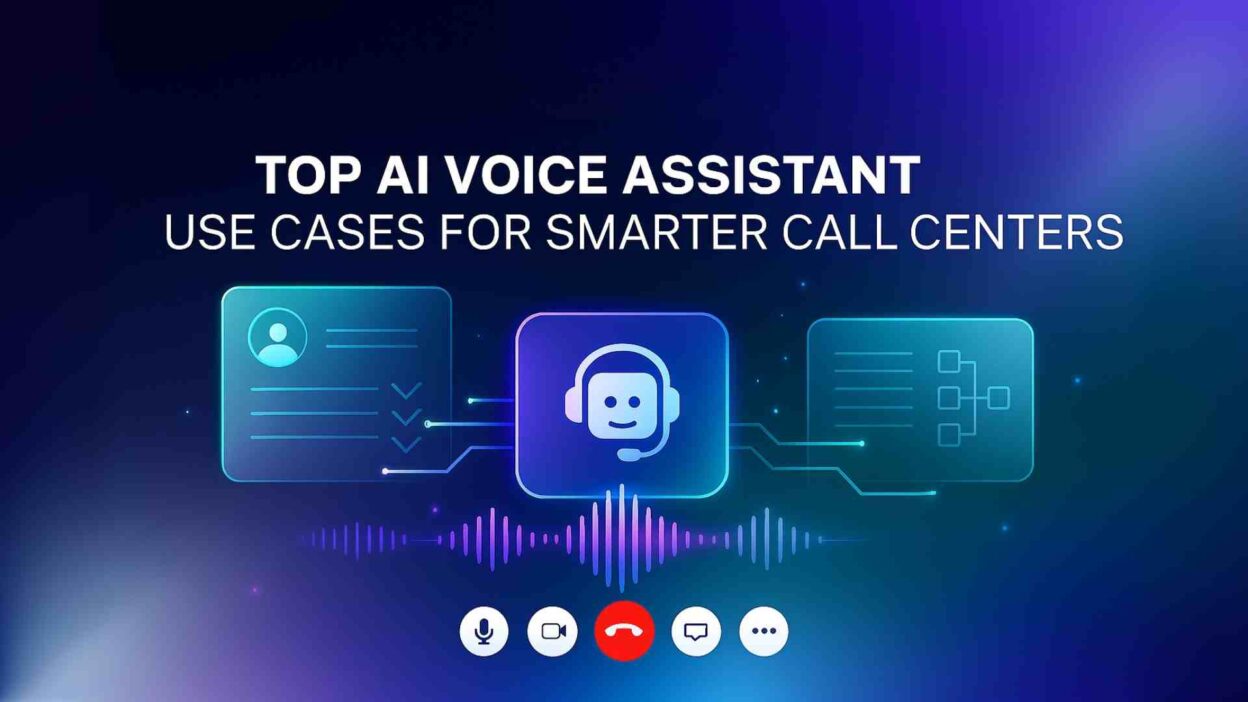TL;DR Call centers have transformed dramatically with the introduction of artificial intelligence technology. Voice assistants now handle complex customer interactions with remarkable accuracy and efficiency. Understanding AI voice assistant use cases in call centers helps businesses improve customer service while reducing operational costs.
Table of Contents
Modern customers expect instant responses and personalized service experiences. Traditional call center operations often struggle to meet these demanding expectations consistently. AI voice assistants bridge this gap by providing 24/7 availability and consistent service quality.
The integration of voice AI technology revolutionizes how call centers operate and serve customers. These intelligent systems can understand natural language, process requests, and provide accurate responses instantly. Organizations worldwide implement AI voice assistants to stay competitive in today’s service landscape.
This comprehensive guide explores the most effective AI voice assistant applications in call center environments. Each use case demonstrates measurable benefits and practical implementation strategies. Your organization can leverage these insights to enhance customer satisfaction while optimizing operational efficiency.
Understanding AI Voice Assistant Technology
AI voice assistants combine multiple advanced technologies to simulate human conversation capabilities. Natural language processing enables these systems to understand spoken words and interpret customer intent accurately. Speech recognition technology converts audio input into digital text for processing and analysis.
Machine learning algorithms continuously improve voice assistant performance through experience and data analysis. These systems learn from every interaction to provide better responses and more accurate solutions. Deep learning models recognize patterns in customer behavior and preferences over time.
Cloud-based infrastructure powers most modern AI voice assistant platforms. Scalable computing resources handle multiple simultaneous conversations without performance degradation. Real-time processing ensures customers receive immediate responses to their inquiries and requests.
Voice synthesis technology creates natural-sounding responses that customers find engaging and professional. Advanced text-to-speech engines produce human-like voices with appropriate tone and inflection. Emotional intelligence capabilities allow voice assistants to adjust their communication style based on customer sentiment.
Integration capabilities connect voice assistants with existing call center systems seamlessly. CRM platforms, knowledge bases, and ticketing systems share data in real-time. This connectivity ensures voice assistants access complete customer information during every interaction.
Automated Customer Service and Support
AI voice assistants excel at handling routine customer service inquiries without human intervention. Common questions about account balances, order status, and basic troubleshooting receive instant responses. Automated handling reduces wait times and frees human agents for complex issues.
Self-service capabilities empower customers to resolve simple problems independently through voice interactions. Password resets, appointment scheduling, and information updates occur through natural conversation. Customer empowerment improves satisfaction while reducing operational costs significantly.
Multi-language support enables voice assistants to serve diverse customer populations effectively. Language detection automatically identifies customer preferences and switches to appropriate language models. Global organizations benefit from consistent service quality across different markets and regions.
Issue escalation protocols ensure complex problems reach human agents when necessary. Smart handoff procedures provide agents with complete conversation context and customer history. Seamless transitions prevent customers from repeating information they already provided to the voice assistant.
Resolution tracking monitors customer satisfaction with automated service interactions. Feedback collection helps identify areas where voice assistants need improvement or additional training. Continuous optimization ensures automated service quality meets customer expectations consistently.
Knowledge base integration provides voice assistants with access to current product information and policies. Real-time updates ensure responses remain accurate and relevant to customer inquiries. Automated content synchronization prevents outdated information from reaching customers through voice interactions.
Interactive Voice Response Enhancement
Traditional IVR systems frustrate customers with complex menu structures and limited options. AI voice assistants replace rigid menu trees with conversational interfaces that understand natural language. Customers can speak their requests in their own words rather than navigating predetermined options.
Intent recognition capabilities identify what customers want to accomplish from their initial statements. Voice assistants route calls appropriately without requiring customers to listen to lengthy menu options. Intelligent routing improves first-call resolution rates and customer satisfaction scores.
Dynamic response generation creates personalized IVR experiences based on customer history and preferences. Frequent callers receive customized greetings and shortcuts to commonly requested services. Personalization makes customers feel valued and reduces interaction time significantly.
Call deflection strategies use voice assistants to resolve issues before customers reach human agents. Many problems that traditionally required agent intervention can now be handled through intelligent voice interactions. Deflection reduces queue times and improves overall service efficiency.
Context retention allows voice assistants to maintain conversation continuity throughout extended interactions. Customers can ask follow-up questions without starting over from the beginning. Contextual understanding creates more natural and efficient customer service experiences.
Omnichannel integration ensures consistent experiences across voice, chat, and digital channels. Customer context and conversation history transfer seamlessly between different interaction methods. Unified experiences improve customer satisfaction and brand perception.
Appointment Scheduling and Management
Voice-activated appointment booking eliminates the need for customers to navigate complex online scheduling systems. Customers can request appointments using natural language and receive confirmation instantly. Automated scheduling reduces administrative workload while improving customer convenience.
Calendar integration synchronizes appointment data across multiple systems and platforms in real-time. Double-booking prevention ensures scheduling accuracy and prevents conflicts. Real-time availability checking provides customers with current appointment options immediately.
Reminder services automatically contact customers before scheduled appointments to confirm attendance. Customizable reminder timing accommodates different customer preferences and appointment types. Automated reminders reduce no-show rates and improve resource utilization significantly.
Rescheduling capabilities allow customers to modify appointments through voice interactions without agent assistance. Flexible scheduling options accommodate changing customer needs and preferences. Self-service rescheduling reduces call volume while improving customer satisfaction.
Waitlist management enables customers to join priority lists for earlier appointment availability. Automatic notifications inform customers when preferred appointment times become available. Smart waitlist management maximizes appointment utilization while serving customer preferences.
Multi-location support handles scheduling across different office locations and service providers. Location-based availability checking ensures customers receive accurate scheduling information. Geographic scheduling optimization reduces travel time and improves service accessibility.
Payment Processing and Account Management
Secure payment collection through voice interactions provides convenient customer service options. Voice assistants can process credit card payments, bank transfers, and digital wallet transactions safely. PCI compliance ensures all payment data handling meets industry security standards.
Account balance inquiries receive instant responses without requiring agent involvement. Voice assistants access real-time account information to provide accurate balance and transaction details. Automated account access reduces call volume while improving customer self-service capabilities.
Bill payment reminders proactively notify customers about upcoming due dates and payment options. Customizable notification preferences accommodate different customer communication styles. Proactive reminders reduce late payments and improve customer account management.
Dispute resolution workflows guide customers through complaint processes using voice interactions. Automated case creation and tracking ensure customer concerns receive appropriate attention. Structured dispute handling improves resolution speed and customer satisfaction.
Credit monitoring services alert customers about account changes and potential security issues. Voice assistants can explain credit report information and provide improvement recommendations. Automated credit services add value while reducing the need for agent consultations.
Fraud detection capabilities identify suspicious account activity and notify customers immediately. Voice verification systems confirm customer identity before discussing sensitive account information. Security measures protect customer data while maintaining convenient access to account services.
Lead Generation and Sales Support
Qualifying potential customers through voice interactions improves sales team efficiency and conversion rates. AI voice assistants ask relevant questions to determine customer needs and purchase intent. Qualified leads receive priority attention from sales representatives.
Product information delivery provides detailed specifications and pricing through conversational interfaces. Voice assistants can explain complex products and services in customer-friendly language. Informed customers make purchasing decisions more quickly and confidently.
Upselling opportunities emerge naturally during customer service interactions handled by voice assistants. Smart recommendation engines suggest relevant products based on customer history and preferences. Automated upselling increases revenue while providing additional customer value.
Appointment setting for sales consultations streamlines the lead-to-meeting process significantly. Voice assistants can schedule product demonstrations and sales meetings automatically. Efficient appointment setting accelerates sales cycles and improves conversion rates.
Follow-up scheduling ensures potential customers receive appropriate attention after initial contact. Automated follow-up reminders help sales teams maintain consistent prospect communication. Systematic follow-up processes improve lead nurturing and conversion outcomes.
Quote generation capabilities provide customers with pricing information instantly during voice interactions. Real-time pricing calculations consider customer-specific discounts and promotional offers. Immediate quote delivery improves customer experience and sales cycle speed.
Technical Support and Troubleshooting
Diagnostic procedures guide customers through systematic problem-solving steps using voice instructions. AI voice assistants can identify common technical issues and provide resolution guidance. Automated troubleshooting resolves many problems without requiring technical support agents.
Step-by-step instructions delivered through voice interactions help customers perform complex technical procedures. Clear verbal guidance reduces confusion and improves success rates for self-service support. Voice-guided support accommodates customers who prefer audio instructions over written documentation.
System status information provides real-time updates about service outages and technical issues. Customers can check system availability and receive estimated resolution times through voice inquiries. Proactive status communication reduces support call volume during outage situations.
Device compatibility checking helps customers determine whether products will work with their existing equipment. Voice assistants can analyze customer requirements and recommend compatible solutions. Compatibility verification prevents purchase mistakes and reduces return rates.
Software update notifications inform customers about available improvements and security patches. Voice assistants can explain update benefits and guide customers through installation processes. Automated update communication improves system security and customer satisfaction.
Remote assistance coordination connects customers with technical support agents when necessary. Voice assistants collect preliminary information and prepare agents for efficient problem resolution. Coordinated support handoffs improve first-call resolution rates and customer experience.
Quality Assurance and Compliance Monitoring
Call recording analysis uses voice recognition technology to evaluate customer interaction quality automatically. AI systems can identify compliance violations, script adherence, and customer satisfaction indicators. Automated quality monitoring reduces supervisor workload while maintaining service standards.
Compliance verification ensures voice assistants follow regulatory requirements and company policies consistently. Automated monitoring identifies potential violations and triggers corrective actions immediately. Consistent compliance reduces legal risks and maintains customer trust.
Performance metrics tracking provides detailed analytics about voice assistant effectiveness and customer satisfaction. Key performance indicators help organizations optimize AI voice assistant use cases in call centers. Data-driven insights support continuous improvement initiatives.
Agent coaching recommendations emerge from voice interaction analysis and customer feedback. Specific training needs identification helps supervisors provide targeted development support. Personalized coaching improves agent performance and customer service quality.
Customer sentiment analysis reveals emotional patterns and satisfaction levels throughout voice interactions. Sentiment tracking helps identify successful interaction techniques and areas needing improvement. Emotional intelligence insights improve overall customer experience design.
Audit trail creation maintains detailed records of all voice assistant interactions for compliance purposes. Comprehensive documentation supports regulatory reporting and internal quality assurance processes. Detailed audit trails protect organizations from compliance risks and legal challenges.
Integration with Existing Call Center Systems
CRM synchronization ensures customer data remains current across all interaction channels and systems. Real-time data updates improve voice assistant accuracy and personalization capabilities. Synchronized systems provide agents with complete customer context during escalated interactions.
Ticketing system integration automatically creates support cases from voice assistant interactions when necessary. Case tracking and management workflows continue seamlessly from voice interactions to resolution. Integrated ticketing improves issue resolution tracking and customer communication.
Knowledge management platform connections provide voice assistants with access to current information and procedures. Centralized knowledge bases ensure consistent responses across all customer service channels. Updated information delivery improves accuracy and reduces misinformation risks.
Workforce management system integration optimizes staffing based on voice assistant performance and call deflection rates. Predictive analytics help managers plan appropriate agent coverage levels. Integrated workforce planning improves service levels while controlling operational costs.
Analytics platform connectivity enables comprehensive reporting across all customer interaction channels. Unified analytics provide complete visibility into customer service performance and trends. Integrated reporting supports strategic decision-making and continuous improvement initiatives.
Third-party application integration extends voice assistant capabilities through specialized tools and services. API connections enable custom functionality development and enhanced feature sets. Flexible integration options accommodate unique business requirements and industry needs.
Measuring Success and ROI
Call volume reduction metrics demonstrate voice assistant effectiveness in handling customer inquiries automatically. Deflection rates show how many interactions avoid human agent involvement successfully. Volume reduction directly translates to cost savings and improved operational efficiency.
Customer satisfaction improvements reflect the quality impact of AI voice assistant implementations. Survey scores and feedback analysis reveal customer perception changes over time. Satisfaction improvements validate investment decisions and support expansion planning.
First-call resolution rates improve when voice assistants provide accurate information and effective problem-solving guidance. Resolution tracking shows how often customers complete interactions successfully without additional contact. Improved resolution rates reduce costs and improve customer experience.
Average handling time reductions occur when voice assistants handle routine inquiries efficiently. Time savings free human agents to focus on complex issues requiring specialized expertise. Handling time improvements increase overall call center capacity without additional staffing.
Cost per interaction calculations demonstrate the financial benefits of voice assistant automation. Labor cost reductions and efficiency improvements contribute to overall cost reduction. ROI analysis supports business cases for expanded voice assistant deployments.
Revenue impact measurement tracks upselling success and customer retention improvements from voice assistant interactions. Sales opportunities and customer loyalty improvements contribute to revenue growth. Revenue tracking validates voice assistant investments beyond cost reduction benefits.
Implementation Best Practices
Pilot program development allows organizations to test voice assistant capabilities before full-scale deployment. Limited scope implementations provide learning opportunities and risk mitigation strategies. Pilot results inform optimization approaches and expansion planning decisions.
Training data preparation ensures voice assistants understand industry-specific terminology and customer language patterns. Comprehensive training datasets improve accuracy and reduce misunderstanding risks. Quality training data investment pays dividends through better customer experiences.
Change management strategies prepare staff and customers for voice assistant integration into call center operations. Communication plans address concerns and highlight benefits for all stakeholder groups. Successful change management ensures smooth transitions and adoption success.
Performance monitoring establishes baseline metrics and tracks improvement progress throughout implementation phases. Regular assessment identifies successful elements and areas requiring adjustment or optimization. Data-driven monitoring ensures maximum benefit realization from voice assistant investments.
Continuous improvement processes ensure voice assistant capabilities evolve with customer needs and technology advances. Regular reviews identify optimization opportunities and emerging requirements or use cases. Adaptive improvement approaches maximize long-term value from AI voice assistant implementations.
Security implementation protects customer data and ensures compliance with privacy regulations throughout voice interactions. Comprehensive security measures maintain customer trust while enabling innovative service delivery methods. Security investment protects organizations from data breaches and regulatory violations.
Future Trends and Innovations
Conversational AI advancement will enable more sophisticated and natural customer interactions through voice interfaces. Emotional intelligence improvements will help voice assistants understand and respond to customer feelings appropriately. Advanced natural language processing will handle increasingly complex customer requests and scenarios.
Omnichannel voice integration will provide seamless customer experiences across all communication channels and touchpoints. Voice context will transfer between phone calls, chat sessions, and digital interactions automatically. Unified voice experiences will differentiate brands in competitive service markets.
Predictive voice assistance will anticipate customer needs and proactively address potential issues before customers contact support. Behavioral analysis will identify customers likely to need assistance or encounter problems. Proactive voice outreach will prevent problems and improve customer satisfaction significantly.
Augmented agent support will enhance human capabilities through real-time voice assistant guidance and information delivery. AI coaching will help agents improve their performance during live customer interactions. Enhanced agent support will improve service quality while accelerating skill development.
Hyper-personalization will customize every voice interaction based on individual customer preferences, history, and behavioral patterns. AI will tailor communication style, response content, and solution recommendations for each unique customer. Personalized voice experiences will strengthen customer relationships and loyalty.
Voice biometrics integration will provide seamless customer authentication through voice pattern recognition. Secure voice identification will eliminate password requirements while maintaining high security standards. Biometric authentication will improve security while significantly enhancing customer convenience.
Read More: Headless Commerce SEO and JAMstack SEO Implementation Guide
Conclusion

AI voice assistant use cases in call centers demonstrate tremendous potential for transforming customer service operations and experiences. These intelligent systems handle routine inquiries, enhance IVR functionality, manage appointments, process payments, generate leads, provide technical support, and ensure quality compliance. Understanding these applications helps organizations make informed decisions about voice assistant implementation.
Successful deployment requires careful planning, adequate training data, and integration with existing call center infrastructure. Organizations must balance automation benefits with human expertise to achieve optimal customer service outcomes. The strategic implementation of AI voice assistant use cases in call centers provides competitive advantages and operational improvements.
Investment in voice assistant technology delivers measurable returns through reduced costs, improved efficiency, and enhanced customer satisfaction. Early adopters gain market advantages while building capabilities for future service innovations. The question is not whether to implement voice assistants, but how to optimize their deployment for maximum benefit.
Future developments will expand voice assistant capabilities and create new opportunities for call center optimization and customer engagement. Organizations that establish strong voice AI foundations today will be better positioned for tomorrow’s service delivery innovations. Understanding and implementing AI voice assistant use cases in call centers becomes increasingly critical for business success and customer satisfaction.
The transformation of call center operations through voice AI represents a fundamental shift toward intelligent, automated customer service delivery. Companies that embrace this transformation will lead their industries while providing superior customer experiences. The time for voice assistant adoption in call centers is now, and the benefits extend far beyond simple cost reduction.






[…] Read More: Top AI Voice Assistant Use Cases for Smarter Call Centers […]